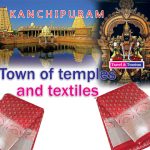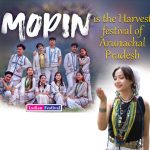Synonymous with spirituality, serenity and silk, the temple town of Kanchipuram, in Tamil Nadu, is dotted with ancient temples that are architectural marvels and a visual treat for the eyes. Situated on the banks of River Vegavathi, this
historical city once had a 1,000 temples, of which only 126 (108 Shaiva and 18 Vaishnava) now remain.
Its rich legacy has been the endowment of the Pallava dynasty, which made the region its capital between the 6th and 7th centuries, and lavished upon it architectural gems that are a fine example of Dravidian styles. While the temple trail makes for an entrancing experience, the renowned Kanjeevaram sarees crafted in the city are truly aweinspiring. Premium sarees made with
superior-quality silk, these are known for their lustre, weight and gold zari work that make the wearer look graceful.
Kanchipuram was also an important centre for Buddhism, and home to monks such as Bhikshu Bodhidharma, Sri Sankaracharya and Sirutho.
The town is also considered an important centre for learning and houses several colleges associated with the University of Madras in Chennai.
The legacy of Kanchipuram through its spiritual attractions
Sri Kamakshi Temple
The name Kamakshi refers to Goddess Saraswati (goddess of education) and Goddess Lakshmi (goddess of wealth), where ‘ka’ means Saraswati, ‘ma’ means Lakshmi and ‘akshi’ means eye. The imposing temple is dedicated to Goddess Kamakshi
(considered as the ultimate form of Goddess Parvati). The deity of this temple is unique in that instead of the traditional standing position, her idol is in the yogic position of padmasana. She is seen holding a sugarcane bow and five
flowers in the two of her lower arms, and a pasha (lasso), and an ankusha (goad) in her two upper arms.
The goddess is flanked by the holy trinity (Lord Shiva, Lord Vishnu and Lord Brahma).Here, an annual festival is held on the ninth lunar day in the months of February and March. During other festivals such as Navratri and Sankara Jayanti,
the temple is especially crowded, receiving hundreds of tourists every day. It is also one of the 51 shaktipeethas or devotional shrines where the severed body parts of Goddess Sati fell.The temple, spread over 5 acre, is open till 8:30 pm
at night, and is lit up like a jewel after sundown, transforming into an alluring visual treat for devotees and photographers alike. Four services are offered every day, starting with pujas in reverence of the elephants that live here.
Mamandur
Around 15 km from Kanchipuram stands the rock-cut cave temple of Mamandur on the banks of River Palar. Built during the early years of the Pallava rule, the cave temple has been declared by the Archaeological Survey of India as a monument
of national importance. The temple’s main attraction is an inscription in the Tamil Brahmi script. Brahmi is the earliest Indian alphabetical script and has several regional variations, one of which is Tamil Brahmi. The inscription is said
to have been laid down sometime between 300 BC and 300 CE. The caves of the temple, another point of interest here, were commissioned by Pallava king Mahendravarman I. There are four cave temples cut into the hills in the area, two of which
lie in Mamandur, and the others in the neighbouring village of Narasapalaiyam. The first cave temple is reached via a stone staircase, and the façade comprises pillars built in the Mahendravarman style of architecture. The second cave
temple has an ardha mandapa and a mukha mandapa, and is dedicated to Lord Brahma, Lord Shiva and Lord Vishnu. The third and the largest temple is only partially complete, with five empty shrines right at the back. The fourth and the
smallest cave temple is also incomplete, and has two pillars and two pilasters supporting the roof.
Ekambareswarar Temple
An architectural marvel, the Ekambareswarar Temple is spread over a vast area of 40 acre. Its most striking feature is the main entrance or the raja gopuram that rises to an imposing height of 172 ft. Entering through this gate feels like
stepping into a different era, such is the grandeur of the structure.
A pillared hall sits in front of the sanctum, and there are idols of the 63 Nayanmars across the place. As you move further into the temple, you will come across two
water tanks known as Shivaganga and Kampa Nadi. The main shrine showcases a Somaskanda panel, which features Lord Shiva, Goddess Parvati and Skanda epic.
Built by the Pallava rulers, Ekambareswarar Temple has 1000 pillared halls and five
prakarams or enclosures. With Lord Shiva as the presiding deity, who is worshipped here as prithvi (earth), the temple was later renovated by the Chola and Vijayanagara rulers. During the rule of Krishnadeva Raya, the gopuram (gateway
tower) and the outer walls were constructed in 1509 AD. Just behind the sanctum stands a 3,500-year-old mango tree that still bears fruits.
The temple is an important religious site of the Hindu sect of Saivism, as one of the temples of the
Panch Bhoota Stalas, or the five elements. Lord Shiva is represented by his most famous symbol, the lingam, and this particular one is known as Prithvi Lingam. The lord’s divine consort Goddess Parvati is also worshipped here in the avatar
of Gowridevi Amman. The best time to visit is during the festival of Phalguni that continues for 13 days. During this time, Ekambareswarar Temple is decked to the nines, as it prepares for the wedding of Lord Shiva and Goddess Parvati.
Thiruporur
Dating back to the period of the Pallava rulers, the ancient temple of Thiruporur is one of the 33 most important temples of Lord Muruga. Its name translates to the place of the holy war. It faces east, sitting in the shadow of the Pranava
Mountain. Lord Muruga’s triumphs are represented in the positioning of the temple. According to the Puranas, Thiruporur is hailed as the Aghayamarg (skies) where the lord fought and won against demons. The temple houses inscriptions dating
back to the 10th century, including some from the 12th century Chola dynasty. One of the inscriptions alludes to the temple being built by the Pallavas.
The temple was lost for many years, before it was rediscovered and restored by Chidambara Swamigal, said to be a descendant of one of the poets of the Tamil Sangam of Madurai.
Thiruporur celebrates festivals all year round, but it’s more important ones are Vaikasi Visagam, Kanthasashti, and Navaratri. The construction
of the Kailasanathar Temple began during the rule of Pallava king, Rajasimha (695 AD -722 AD) and was completed in the 8th century by Mahendravarman III, of the Pallava dynasty.Visited by tourists from India and abroad, perhaps the most
popular attraction of the temple is the inner-most pathway that runs around the idol of Kailasanathar, signifying the entry of a person’s soul into paradise. Lord Shiva’s vehicle, Nandi (bull god), is also worshipped here. The temple
compound is made of stone, so the best times to visit are mornings and evenings, because the stone heats up under the harsh afternoon sun, and makes walking barefoot a challenge.
Kailasanathar Temple
Dedicated to Lord Shiva, the lord of Mt Kailash, the Kailasanathar Temple is among the most important temples in town. The large temple complex has 60 smaller shrines, but one of the most unique aspects is the main idol of Lord Shiva, which
has 16 stripes. The architecture of the temple is in traditional Pallava style of pillared halls, a vestibule and a pyramidal tower. There are 240 or so panels engraved into the temple walls that display Nagara and Pallava Grantha scripts;
incidentally, some of the earliest works of calligraphy are also found at Kailasanathar Temple. It holds one of the earliest sculptures of Jyeshta Lakshmi (Moodevi) and Vaali as well. Showcasing Dravidian style of architecture, this place
is ideal for meditation and reflection.

















Add Comment